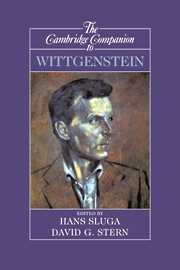Book contents
- Frontmatter
- Ludwig Wittgenstein
- 1 Wittgenstein's critique of philosophy
- 2 Pictures, logic, and the limits of sense in Wittgenstein's Tractatus
- 3 Fitting versus tracking
- 4 Philosophy as grammar
- 5 A philosophy of mathematics between two camps
- 6 Necessity and normativity
- 7 Wittgenstein, mathematics, and ethics
- 8 Notes and afterthoughts on the opening of Wittgenstein's Investigations
- 9 Mind, meaning, and practice
- 10 “Whose house is that?” Wittgenstein on the self
- 11 The question of linguistic idealism revisited
- 12 Forms of life
- 13 Certainties of a world-picture
- 14 The availability of Wittgenstein's philosophy
- Bibliography
- Index
10 - “Whose house is that?” Wittgenstein on the self
Published online by Cambridge University Press: 28 May 2006
- Frontmatter
- Ludwig Wittgenstein
- 1 Wittgenstein's critique of philosophy
- 2 Pictures, logic, and the limits of sense in Wittgenstein's Tractatus
- 3 Fitting versus tracking
- 4 Philosophy as grammar
- 5 A philosophy of mathematics between two camps
- 6 Necessity and normativity
- 7 Wittgenstein, mathematics, and ethics
- 8 Notes and afterthoughts on the opening of Wittgenstein's Investigations
- 9 Mind, meaning, and practice
- 10 “Whose house is that?” Wittgenstein on the self
- 11 The question of linguistic idealism revisited
- 12 Forms of life
- 13 Certainties of a world-picture
- 14 The availability of Wittgenstein's philosophy
- Bibliography
- Index
Summary
“Think of a picture of a landscape, an imaginary landscape with a house in it. - Someone asks 'whose house is that?' - The answer, by the way, might be 'It belongs to the farmer who is sitting on the bench in front of it' But then he cannot for example enter his house” (PI, 398). Wittgenstein tells this mild joke in the midst of a discussion on the self, the I, or better: on the ways we use the word “I”. The gist of his discussion appears to be that there is no self to which the “I” might refer. But how does the jocular story fit in? Does it suggest that it is not I who imagines the landscape, house, and farmer? Does the farmer stand for the self even though there is no such thing? What does it mean that he can own but not enter the imagined house? What does the story tell us about the I and/or the “I”? There is a roundabout answer to all this.
Wittgenstein reflected on questions concerning the mind, mental states, processes, and acts throughout his life and in that context he came regularly back to the I, self, soul, or subject as he called it more or less indiscriminately. The first time he talks about the mind - in the middle of a difficult passage on the things that make up the world-he announces unexpectedly: “There really is only one world soul, which I for preference call my soul. . .” (NB, p. 49) and a few weeks before his death, thirty-six years later, he writes in another notebook: “But it is still false to say: . . . I is a different person from L.W” (LWII, p. 88).
- Type
- Chapter
- Information
- The Cambridge Companion to Wittgenstein , pp. 320 - 353Publisher: Cambridge University PressPrint publication year: 1996
- 30
- Cited by



